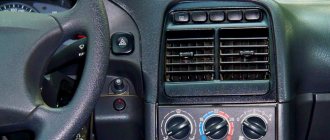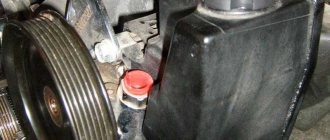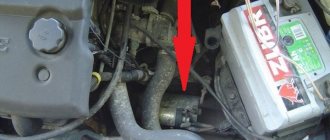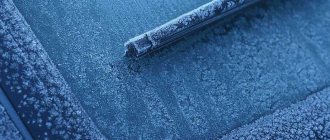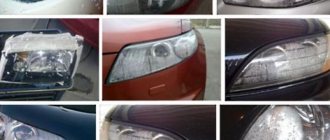Winter is a difficult period for a car owner. A car parked overnight in a parking lot or near a house freezes over and requires at least half an hour in the morning to warm up and clear snow and ice. Car windows require special attention - on a winter road you need full visibility, and they must be cleaned.
How to quickly warm up a windshield that is covered with a crust of ice? In modern cars today, “soft” glass is installed, which reduces the risk of injury to the driver in an accident, but requires very careful handling in winter. Glass surfaces can be easily scratched or damaged when cleared of ice. Therefore, heating the windshield requires the use of only gentle technologies.
What to use to remove ice from car windows
In the morning, everyone is usually in a hurry to go to work and on errands; there is often no time for long-term “gentle” heating of the windshield, and you have to warm the glass quickly. The simplest option is to turn on the heater in the cabin and direct the airflow onto the glass. This method is good in two cases: you have time to fully warm up the car, or there was no severe frost outside, and the glass was slightly frosted.
If there was severe frost and a thick crust of ice formed on the glass, short and powerful heating is dangerous - the windshield may simply crack from a sharp temperature change. Trying to melt ice with boiling water will give the same sad result.
Therefore, you need to warm up the windshield carefully, using less aggressive methods and additional equipment.
Plastic scraper and brush
If there is no heavy ice on the car glass, and the stuck snow has a more or less loose structure, you can try to remove it with a scraper and brush. An experienced driver always carries such equipment with him in the trunk in winter.
The scraper should be covered with soft plastic or thick rubber. Metal and hard plastic scrapers are excluded - you will simply scratch the glass. But even a soft scraper should be used to a minimum and very carefully. At the same time, you should start the stove to warmly (not maximally!) blow the glass from the inside and wait a little until the bottom layer of ice is slightly flooded - then the layers of ice will easily slide over the formed film of water under the action of the brush.
Important point! You can remove ice with a plastic scraper only from a clean windshield. If it's covered in dirt, you risk scratching the surface with sharp grains of sand.
Heater
To avoid mechanical damage to the windshield, it is better to use only the heater. To do this, it is better to turn on the stove when the engine is not running to prevent the glass from cracking due to strong temperature changes. Within 10-15 minutes the ice will melt and it can be cleaned off with a regular brush.
Second option: start the engine and heater to heat the interior to maximum, and direct minimal airflow onto the glass. While the engine is heating up, the glass will be blown first with cold air, and then with increasingly warmer air. At the same time, you can turn on recirculation so that the blower takes warm air from the cabin, and not cold air from the street.
There is a risk of getting a crack in the glass only if you first warm up the car engine and then direct a strong stream of hot air onto the glass. This method of heating is especially dangerous if the “lobovukha” already has old cracks from mechanical damage.
Warm water
Ice on the car window can be melted with water if you don’t have time to blow it off. This is an old proven method, but the water must be warm - no more than 50°C, and it must be poured onto the glass slowly. A thin layer of ice will quickly melt, but a thick layer will flood from below and can be scraped off with a scraper.
Never pour boiling water on the glass! With a sharp temperature change, the surface may crack, especially if it already has small mechanical cracks.
Glass defroster
Do you want to quickly solve the problem of heating your windshield and clear it of ice without mechanical damage? Use modern auto chemicals - a special glass defroster, which gives the fastest possible effect even in very severe frosts (down to -40°C).
Simply spray the defroster onto your windshield, wait a few minutes, and begin scrubbing the surfaces with a brush.
Try not to buy cheap defrosters - they are ineffective, can corrode the rubber seal on the glass, and some contain methyl alcohol, which is dangerous to humans. It’s better to spend money once and a can of high-quality defrost will last you the whole winter.
Anti-freeze
If the ice crust on the windshield is not too thick, you can clear it by turning on the windshield wipers and windshield washer. Anti-freeze, which is usually poured into the washer reservoir, has a freezing point lower than that of water, which means it will melt the ice on the glass, and then it will be easy to clean it off with wipers and a brush.
The glass washing procedure must be repeated several times to soften and melt the ice. Pre-clean the wiper blades from ice to prevent them from scratching the glass.
Alcohol
Ice from glass surfaces can be easily removed with alcohol (ethyl or isopropyl). Alcohol freezes at temperatures of -90-110°C, and behaves like an anti-freeze agent or a concentrated glass defroster, but melts ice faster.
It is better not to pour alcohol onto a thin layer of ice, but to spray it on the frosted glass. In this case, the ice will instantly begin to defrost and flow down the glass. It is better to soak a thick crust of ice with alcohol, pouring it onto the top of the “lobovukha” so that it flows down freely. The submerged and loosened crust can then be cleaned off with a scraper and brush.
You can dilute the alcohol with water to save liquid. This mixture can be used in frosts no lower than -25°C, but if the winter is not too cold, it will be quite effective.
Why do car windows freeze and how to fix it?
To eliminate this scourge, you need to figure out what happens to the air in the cabin, which, when the temperature drops, leaves condensation on the windows and freezes at sub-zero temperatures.
Every car has vents designed to circulate air, and they often become clogged, both inside and out. In the absence of ventilation, the cooled air has nowhere to escape and the effect of a thermos is obtained.
Attention! To eliminate or check the ventilation, you must contact a car service center. There is also the opposite side of the coin, when there are too many ventilated places in the car, this may be due to damaged door seals, glass, worn locks or hinges in the doors
There is also the opposite side of the coin, when there are too many ventilated places in the car, this may be due to damaged door seals, glass, wear of locks or hinges in the doors.
With increased exposure to outside air, the car interior cools very quickly, and the air, when rapidly cooled, condenses dew on the windows. These faults can also be checked when diagnosing the car at a car service center.
In addition to malfunctions of the car’s ventilation system, there are also many factors in its care and operation. In winter, as a rule, there is snow on the street, which is safely brought into the car along with shoes, because it is not possible to cleanly sweep snow off shoes all the time.
This snow quickly melts in the form of water and ends up on the floor mats. It all depends on the driver what kind of mats he uses in winter. If they are rag, then this material, even rubberized, perfectly absorbs moisture; if you frequently leave and enter the car, these mats can pick up a large amount of melted snow and do not have time to dry out.
Accordingly, after parking the car overnight, the heated mat continues to dry out and evaporate moisture into the cabin air, and then, according to the old scenario, the air cooled down, dew fell on the windows, the windows became covered with frost, and in the morning there was a problem.
This effect can be corrected with the help of rubber mats, which do not absorb moisture, but may not cause much discomfort; when moisture accumulates from the snow, they can collect a small puddle in your feet.
Therefore, during the operating day, you sometimes need to take them out and wipe them with a rag, but this is not particularly convenient. It is also advisable to carry out the same actions before overnight parking.
Fogging and further freezing from the inside of the car windows may be associated with malfunctions of the interior heater system. As soon as a small leak appears, the windows in the cabin begin to sweat; this reason is easily recognized by the characteristic smell of antifreeze.
How to prevent ice formation
If you are tired of cleaning your windshield from ice and snow every day, or you don’t have time for it, it is better to take care of glass maintenance so that there is no ice, or less ice. There are several simple and easy ways to do this.
Ventilation of the interior
After you park your car in the parking lot or near your house in the evening, open the doors for 5 minutes and let the cold air enter the cabin. If the temperature inside the car is not much higher than outside, the windows freeze less. A couple of minutes before parking, you can also turn off the heater in the cabin.
Covering glass
The old way is to cover the frontal area with a car blanket at night. In the morning, all the ice will accumulate on it, and the glass will not need to be cleaned and defrosted. To prevent the blanket from being blown away by the wind or to prevent it from being stolen, press the edges of the fabric with the front doors closed and the fabric itself with windshield wipers. Instead of a blanket, you can also use plastic film (it does not get wet and does not freeze to the glass).
Hydrophobic glass treatment
To reduce the frosting of car windows, they can be periodically treated with “anti-rain”, which creates a thin water-repellent film on the glass. Moisture does not stay on the surface and flows down, but at the same time it does not freeze into a strong ice crust and is easily cleaned off in the morning.
Wiper protection
Sometimes, in severe frost, windshield wiper blades freeze to the windshield. When they are turned on, the electric motor of the windshield wipers may fail. To avoid having to bother with the wipers in the morning, periodically treat them with silicone. It repels moisture and creates a thin waterproof film on the brushes.
To solve a problem, you first need to understand it
You must understand that car windows freeze due to temperature changes and high humidity. Let's look at the process in more detail. The temperature outside is dropping. The same thing happens inside the car. As a result, the moisture in the air crystallizes and settles on the windows.
The plaque that forms on windows not only interferes with your view, but is also very resistant to attempts to remove it. Moreover, if you show excessive zeal, you can damage the surface.
Then you won’t be able to do without grinding and polishing.
Perhaps you have often wondered why the windows freeze in your car? It's all about the unique properties of glass. The thermal insulation coefficient of this material is very low. Especially if you compare this indicator with the indicators of other materials in the car.
Next you need to remember the school physics course. According to the basic postulates, the reaction will take place with minimal energy consumption. Simply put, condensation accumulates on windows due to their minimal resistance to this process.
Oddly enough, it is the windshield that freezes the hardest.
Provided, of course, that the car is not equipped with special heating devices. The fact is that the surface of the windshield is inclined, and this creates even more favorable conditions for the accumulation of frost.
Important! The rate of icing of the windshield in a car is also affected by the snow that falls and settles on it.
Antifreeze for car windows in winter
Using windshield wipers to warm and clear ice and snow from your windshield is an effective solution. However, you should choose this type of auto chemicals very carefully: some aerosols contain substances harmful to car coatings or methyl alcohol, which is dangerous to humans.
Another thing is windshield cleaning fluids mixed with your own hands. Here you will know exactly the composition of the components and their dosage. Experienced car enthusiasts use their own windshield wipers and recommend two types of such liquids - alcohol-based and salt-based solutions.
Alcohol based glass cleaner
The solution contains alcohol, water and household dishwashing detergent (the latter component is desirable, but not required). Alcohol is mixed with water in a 2:1 ratio, after which a few drops of washing gel are dissolved in the solution, and the finished liquid is poured into a container with a sprayer. When you spray it on a frost-bitten windshield, you will get the fastest possible result - it melts instantly and is removed with a brush.
Salt based glass cleaner
If you don’t have alcohol on hand, you can add salt to the water (8-10 tablespoons of salt per 5 liters of water). The solution also needs to be poured into a container with a spray bottle. It is not as effective as an alcohol mixture, but. If you apply it to the glass and wait a few minutes, the ice will loosen and can be easily removed.
Note! It is not advisable to use a salt glass cleaner often - salt corrodes the sealing rubber and causes corrosion of metal surfaces.
In conclusion, it should be noted that driving a car with a frozen windshield in winter. A snow-covered road requires special attention and full driver visibility, so you should drive out onto the road only after the front wheel has been completely cleared.
However, glass requires careful handling, and in order to protect it from scratches and cracks, mechanical forces should be used to a minimum when removing ice from surfaces. It is better to first melt the ice with warm water, gentle airflow from the stove in the cabin, anti-freeze, alcohol, purchased or independently mixed windshield wipers.
Is it possible to make a glass defroster with your own hands?
Making your own liquid to defrost car glass
Almost all offered defrosters have a common active ingredient – alcohol. So you can easily prepare your own ice remover at home. It is only important to maintain the proportions, as well as find the appropriate type of alcohol-containing liquid. And folk remedies do not have to be specially prepared at all. You just pick it up and rub the car window so that it doesn’t freeze and the ice melts.
In most cases, a do-it-yourself defroster will not only be as effective as a purchased one, but also, on top of everything, almost completely free. Suffice it to recall the school chemistry course.
4) Why is your own liquid better than store-bought?
Your own prepared liquid, which protects glass from freezing, is an excellent alternative to expensive special products that are sold in stores today. Despite the huge advertising of such antifreeze and cleaning products, their effectiveness will not be much different from your own liquid, since the composition of such products is based on the same simple vinegar.
Washing
Any self-respecting car owner tries to keep his “iron horse” clean. In winter we have to do this more often on our roads. But washing in such conditions can be dangerous not only due to stuck seals, but also due to a fogged windshield. What is the reason? The problem is the moisture that remains after washing. Moreover, even those who washed the car in a box at zero temperature face this problem.
The moisture remaining in the cabin turns into a hard ice crust on the windshield overnight. What is the way out of the situation? If the windows in your car freeze from the inside, what should you do? Of course, not washing your car at all until the warm weather in May is not an option. Experts recommend ventilating the car interior immediately after washing. And do this not in a box (since the humidity there is always 100 percent), but on the street. It is enough to drive the car onto the site and open all the doors wide. After 10-15 minutes you can begin normal use.
Cleaning outside
There are only a couple of old-fashioned methods that still work. First
- this is temperature equalization.
It doesn't matter how you do it. We turn off the engine - turn off the stove - lower the windows (two front ones or all four) - open the doors. The main thing is to stand in this way for a couple or three minutes (this is enough) for the warm air to escape. AND THAT'S ALL! The glass will freeze significantly less.
If you stand like this, there is no desire - the men in the parking lot will laugh. You can lower one side window at night, not too much, say 5 mm (just leave a gap).
Warm air, according to the laws of physics, will come out through it, the temperature balance will be equalized with the street - again, the glass will freeze much less. BUT! This method is only relevant in a well-guarded parking lot (do not tempt thieves)
Instructions to prevent windows from freezing at night in winter
Frosts are approaching, and the windows on our cars freeze tightly overnight. Then in the morning you need to spend a lot of time defrosting the windshield, especially if you do not have a heated windshield installed. You cannot drive with such a frozen windshield - this is considered a malfunction in which driving the car is prohibited. How to ensure that the glass does not freeze overnight?
It is important what material the glass is made of. Modern cars use athermal glass, which conducts heat poorly and moisture quickly evaporates from their surface.
Don't rub!
Remember that if you try to remove ice mechanically, it will not quickly achieve the desired result - and the harder you scrub, the more scratches and scuffs you will leave on the glass. After all, some drivers do not use a special car scraper for these purposes, but use bank cards or other improvised means.
Someone pours hot water on the windshield - some of the ice may melt, but in the cold it will freeze again, covering the glass with a crust of ice on top of what has already formed. In addition, temperature changes can cause glass to crack.
Life hacks on how to avoid heavy ice
- Shortly before you leave your car in the parking lot, turn off the heater and open the windows slightly to equalize the temperature inside and outside the car.
- When you have already driven, you can open the side window slightly and point the heater at the windshield.
- Do not scrape the windows immediately when you approach a frozen car - first warm up the interior, and then it will be much easier to remove the ice.
- You can use special auto chemicals that protect glass from freezing. True, drivers complain that the effectiveness of these products is not very high.
- In winter, use textile mats that absorb moisture rather than rubber mats—with rubber mats, you will always have troughs of water under your feet.
Experienced drivers have a lot of tricks to prevent car windows from freezing when you park your car overnight.
Some people treat glass with vinegar diluted with water in the evening. This mixture is poured into a spray bottle and distributed over the glass. You can use a cloth to collect the remains.
A common folk way to combat ice is to mix glycerin and steamed salt at a ratio of one to one and lubricate the outside of the glass.
Plastic car covers can help.
You can spray the glass with a solution of vodka and water in a two to one ratio.
Of course, if your car is stored in a warm garage or covered parking lot, then there will be no problems with freezing. But for modern drivers it's a luxury. In addition, owners of climate control in their cars do not have a big problem with persistent ice.
Related article: Plastic windows with one glass for the veranda
Cause
The cause of freezing is accumulated condensation. Under the influence of temperatures, moisture begins to crystallize. As a result, a hard ice crust forms on the inner surface of the glass. Moreover, owners encounter this problem even after parking the car for a long time. Why does moisture accumulate on glass? Everything is very simple. The material of this element has the lowest heat transfer coefficient. From the physics course, it becomes clear why all the moisture settles on the glass, and not on the door trim or rugs. There may be several sources of condensation. If it’s inside the car, what should you do on the VAZ-2110? We need to address the root of the problem.
Rub with vinegar
On the Internet you can find advice to rub the glass with vinegar immediately after parking the car in the evening. Some kind of Stone Age! And it’s also labor-intensive: first wipe the windshield, which is dirty with reagents, clean, then treat it, at the same time freezing and getting dirty on the body. The method, of course, works, but it’s faster and easier to remove the ice in the morning with a regular scraper. Moreover, in cold weather you won’t be able to move right away: you’ll have to warm up the engine for a couple of minutes and let the oil circulate through the channels.
Owners of cars with an electrically heated windshield are freed from problems with frozen windows. Press the button, and after a couple of minutes the melted ice can be easily brushed off with the windshield wiper blades. Owners of cars with an electrically heated windshield are freed from problems with frozen windows. I pressed the button, and after a couple of minutes the melted ice can be easily brushed off with the windshield wiper blades.
6) Other tips
Also, regular vinegar can be used in the summer. For example, diluted vinegar with flavored additives can be added directly to the car washer reservoir. This will help you well when removing heavy dirt from the windshield (for example, vinegar helps to easily clean the glass from insects). Unlike special and not entirely healthy liquids that are sold in car dealerships today, adding vinegar to the washer reservoir will not harm your health in any way.
